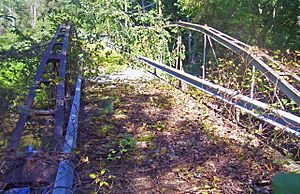Shaw Bridge facts for kids
Quick facts for kids Shaw Bridge |
|
|---|---|

View from south end, 2008
|
|
| Coordinates | 42°12′55″N 73°43′44″W / 42.21528°N 73.72889°W |
| Carries | Van Wyck Lane |
| Crosses | Claverack Creek |
| Locale | Claverack, NY |
| Maintained by | Columbia County Department of Public Works |
| Heritage status | NRHP #80002598 |
| Characteristics | |
| Design | Bowstring truss |
| Material | Iron, wood |
| Total length | 162 feet (49 m) |
| Width | 13 feet (4.0 m) |
| Number of spans | 2 |
| Clearance below | 10 feet (3.0 m) |
| History | |
| Designer | Squire Whipple |
| Constructed by | J. D. Hutchinson |
| Opened | 1870 |
The Shaw Bridge, also known as the Double-Span Whipple Bowstring Truss Bridge, is a very old and important bridge in Claverack, New York. It used to carry a road called Van Wyck Lane over Claverack Creek. Today, the bridge is closed to everyone, even people walking.
This bridge is special because it shows how American engineering and transportation technology developed. It was designed by John D. Hutchinson, using ideas from Squire Whipple. It is the only bridge of its kind in the United States that has two spans and uses the Whipple bowstring truss design.
The Shaw Bridge was added to the National Register of Historic Places in 1980. Since then, its wooden deck has become very old and weak. Because of this, it can no longer be used safely.
How the Bridge Is Built
The Shaw Bridge is in a quiet neighborhood with old houses and many tall trees. The Claverack Creek flows under the bridge. This creek is not very deep but is quite wide here. It flows into the Hudson River further west. The bridge is located a short distance east of the main roads, NY 23 and 9H.
The bridge is a type of bridge called a bowstring tied arch. It has two parts, or "spans," that look exactly the same. These spans are held up by strong supports at each end called abutments. There is also a support in the middle made of stone blocks.
The bottom part of the bridge, called the lower chord, is made of wrought iron. It is about 162 feet (49 m) long and 13 feet (4.0 m) wide. It sits about 10.5 feet (3.2 m) above the water. The top part, or upper chords, are curved pieces of iron. These pieces are joined together at different points. You can see the words "J. D. Hutchinson, Builder, Troy, N.Y., 1870" on them.
Iron beams hold up the bridge's floor. These beams hang from the top part of the bridge using strong iron rods. Other iron rods cross each other to make the bridge even stronger. Wooden planks are laid across these iron beams to form the bridge deck. There are also guard rails on both sides to protect the main structure.
History of Shaw Bridge
The Shaw Bridge was likely built by the state government. In 1870, Van Wyck Lane was an important road, part of the Albany Post Road. Squire Whipple's iron bridge designs were already used for canals, so the state might have decided to use them for roads too. John D. Hutchinson, the builder, came from a family of bridge builders. His father had built many bridges for the Erie Canal. The bridge was named after William Shaw, who owned land nearby.
In 1931, new roads (routes 23 and 9H) were built. This meant less traffic used the Shaw Bridge. It was still used for many years, but with a weight limit of 4 tons. Eventually, its wooden deck became too old and unsafe. Now, fences block the bridge, and tree branches have fallen onto it.
Around 2011, local leaders started to recognize how important this old bridge is. They cleared away weeds and tried to find money to fix it. The goal was to open it again for people to walk across. However, by 2012, the funding plans did not work out. The future of the bridge is still uncertain.
See also
 In Spanish: Puente Shaw para niños
In Spanish: Puente Shaw para niños

